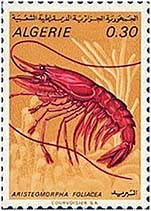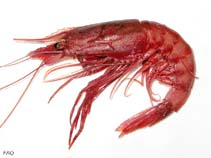Aristaeomorpha foliacea (Risso, 1827)
Giant red shrimp| Native range | All suitable habitat | Point map | Year 2050 |

|
| This map was computer-generated and has not yet been reviewed. |
| Aristaeomorpha foliacea AquaMaps Data sources: GBIF OBIS |
Classification / Names Common names | Synonyms | CoL | ITIS | WoRMS
Malacostraca | Decapoda | Aristeidae
Environment: milieu / climate zone / depth range / distribution range Ecology
Benthopelagic; depth range 60 - 1300 m (Ref. 97594), usually 250 - 750 m (Ref. 409). Tropical; ? - 14°C (Ref. 434), preferred 20°C (Ref. 107945); 55°N - 55°S, 180°W - 180°E
Distribution Countries | FAO areas | Ecosystems | Occurrences | Introductions
Atlantic, the Mediterranean and Indo-Pacific. Tropical to temperate.
Length at first maturity / Size / Weight / Age
Maturity: Lm 3.7, range 3 - 4.414 cm Max length : 17.0 cm TL male/unsexed; (Ref. 104052); 22.5 cm TL (female); max. published weight: 45.90 g (Ref. 126095); max. published weight: 45.90 g; max. reported age: 8 years (Ref. 80203)
Deep-water benthopelagic shrimp (Ref. 114287). Common total length: 12 to 16 cm. Minimum common depth from Ref. 8. Usually caught on muddy and sandy bottoms of continental slopes (Ref. 434).
Life cycle and mating behavior Maturity | Reproduction | Spawning | Eggs | Fecundity | Larvae
Spawning occurs during spring to summer. Females have a life span of 7-8 years while males live for 5-6 years.
Main reference
References | Coordinator | Collaborators
Pérez Farfante, I. and B. Kensley. 1997. (Ref. 75620)
IUCN Red List Status (Ref. 130435: Version 2024-1)
CITES status (Ref. 108899)
Not Evaluated
CMS (Ref. 116361)
Not Evaluated
Threat to humans
Human uses
Fisheries: commercial
FAO - Fisheries: landings | FishSource | Sea Around Us
Tools
More information
Trophic Ecology
Ecology
Population dynamics
Life cycle
Distribution
Human Related
Outreach
Taxonomy
References
Internet sources
BHL | BOLD Systems | CISTI | DiscoverLife | FAO(Fisheries: ; publication : search) | Fishipedia | GenBank (genome, nucleotide) | GloBI | Gomexsi | Google Books | Google Scholar | Google | PubMed | Tree of Life | Wikipedia (Go, Search) | Zoological Record
Estimates based on models
Preferred temperature
(Ref. 115969): 5.9 - 15.7, mean 10 (based on 1552 cells).
Resilience
(Ref. 69278):
High, minimum population doubling time less than 15 months (K=0.37-0.96; tm=1.5; tmax=8).
Prior r = 0.77, 95% CL = 0.51 - 1.16, Based on 4 full stock assessments.
Nutrients : Calcium = 109 [35, 184] mg/100g; Iron = 1.59 [1.21, 1.97] mg/100g; Protein = 20.2 [19.2, 21.3] %; Omega3 = 0.285 [0.185, 0.386] g/100g; Selenium = 48.3 [-31.7, 128.3] μg/100g; VitaminA = 0 μg/100g; Zinc = 1.79 [1.17, 2.40] mg/100g (wet weight); based on nutrient studies.




